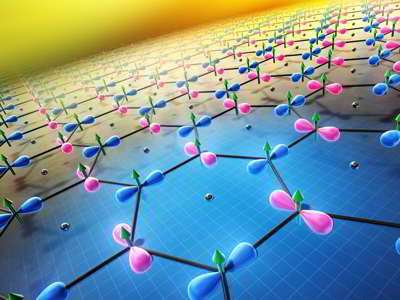MANA Develops Ferroelectric-ferromagnetic Materials for Next-Gen Electronics
Opening doors to advancing spintronics and memory devices
This is a Press Release edited by StorageNewsletter.com on January 9, 2025 at 2:00 pmFrom Research Center for Materials Nanoarchitectonics, Japan
Researchers at the Research Center for Materials Nanoarchitectonics (MANA, Ibaraki, Japan) have proposed a method to create ferroelectric-ferromagnetic materials, opening doors to advancing spintronics and memory devices.
In 1831, Michael Faraday discovered the fundamental connection between electricity and magnetism, demonstrating that a changing magnetic field induces electric current in a conductor.
In a recent study, MANA researchers have proposed a method for designing ferroelectric-ferromagnetic (FE-FM) materials, which exhibit both ferroelectric and ferromagnetic properties, enabling the manipulation of magnetic properties using electric fields and vice versa. Such materials are highly promising for spintronics and memory devices. The advantage of FE-FM materials, extremely rare in nature, is their ability to achieve the cross-control by relatively low electric and magnetic fields. The study, led by Igor Solovyev, principal researcher, MANA, NIMS, included contributions from Dr. Ryota Ono, MANA, NIMS, and Dr. Sergey Nikolaev, University of Osaka, Japan.
Ferroelectric materials possess a permanent electric polarization, usually arising from ion displacement in their crystalline lattice and resulting in the formation of charged electric dipoles, which align in the same direction. The key feature of ferromagnetic materials is the uncompensated magnetic moment produced by electron spins and orbital motion. Combining both properties in a single material is challenging since the ion displacement enabling ferroelectricity can disrupt the magnetic ordering needed for ferromagnetism. Similarly, the ferromagnetic alignment of magnetic moments is not sufficient for breaking the spatial inversion symmetry required for producing ferroelectricity.
The authors of the current study proposed that antiferro orbital ordering, driven by the Kugel-Khomskii mechanism, where electrons tend to occupy alternating orbitals, can promote both ferromagnetic interactions and break the inversion symmetry. When tested on VI3, a van der Waals ferromagnet with a honeycomb structure, this ordering resulted in an FE-FM ground state.
“By properly arranging occupied atomic orbitals in a solid, one can make the material not only ferromagnetic but also ferroelectric,” says Dr. Solovyev, highlighting the potential of this approach for developing next-gen electronic devices based on multiferroic materials and ferroelectric ferromagnets.
Article: Ferromagnetic ferroelectricity due to the Kugel-Khomskii mechanism of orbital ordering assisted by atomic Hund’s second rule effects
Physical Review B has published an article written by I. V. Solovyev, R. Ono, Research Center for Materials Nanoarchitectonics (MANA), National Institute for Materials Science (NIMS), 1-1 Namiki, Tsukuba, Ibaraki 305-0044, Japan, and S. A. Nikolaev, Department of Materials Engineering Science, The University of Osaka, Toyonaka 560-8531, Japan.
Abstract: “The exchange interactions in insulators depend on the orbital state of magnetic ions, obeying certain phenomenological principles, known as Goodenough-Kanamori-Anderson rules. Particularly, the ferro order of alike orbitals tends to stabilize antiferromagnetic interactions, while the antiferro order of unlike orbitals favors ferromagnetic interactions. The Kugel-Khomskii theory provides a universal view on such coupling between spin and orbital degrees of freedom, based on the superexchange processes: namely, for a given magnetic order, the occupied orbitals tend to arrange in a way to further minimize the exchange energy. Then, if two magnetic sites are connected by the spatial inversion, the antiferro orbital order should lead to the ferromagnetic coupling and break the inversion symmetry. This constitutes the basic idea of our work, which provides a pathway for designing ferromagnetic ferroelectrics: the rare but fundamentally and practically important multiferroic materials. After illustrating the basic idea on toy-model examples, we propose that such behavior can be indeed realized in the van der Waals ferromagnet VI3, employing for this analysis the realistic model derived from first-principles calculations for magnetic 3d bands. We argue that the intra-atomic interactions responsible for Hund’s second rule, acting against the crystal field, tend to restore the orbital degeneracy of the ionic d2 state in VI3 and, thus, provide a necessary flexibility for activating the Kugel-Khomskii mechanism of the orbital ordering. In the honeycomb lattice, this orbital ordering breaks the inversion symmetry, stabilizing the ferromagnetic-ferroelectric ground state. The symmetry breaking leads to the canting of magnetization, which can be further controlled by the magnetic field, producing a huge change of electric polarization.“















 Subscribe to our free daily newsletter
Subscribe to our free daily newsletter


